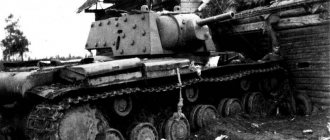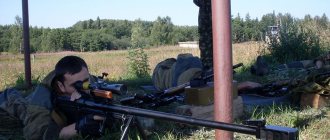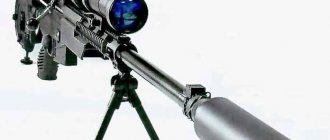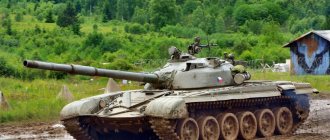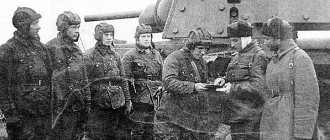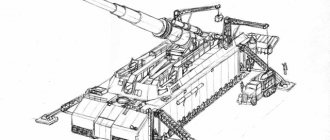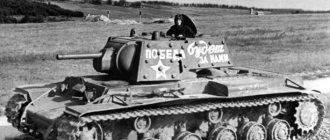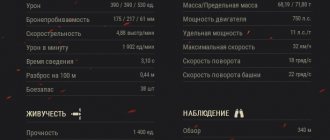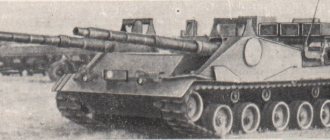The KV-1 heavy tank received its name in honor of Kliment Voroshilov. The history of this vehicle began at the end of 1938, when the USSR arose the need to create a new heavy tank. Similar attempts had also been made before this, but they all ended in failure. Options for tanks with multiple turrets were rejected because they were expensive to produce and unreliable.
Tanks that were too large were also not suitable, because it was impossible to install the required amount of armor on them. In the end, the developers settled on three options: KV-1, T-100 and SMK. Prototypes were created. The Soviet-Finnish company began, and all three tanks were sent to war.
History of the Soviet KV-1 tank
Of all the prototypes, only the KV-1 tank has proven itself better than the others. He first went into battle on December 17, 1939. Not a single Finnish gun could penetrate the KV's armor, and it calmly moved forward, allowing the Soviet troops to go on the offensive. The new heavy tank had only one significant drawback: none of the installed guns could cause any damage to enemy bunkers.
Tank KV-1: museum exhibit
Despite this, the KV-1 heavy tank was considered the best option for mass production, although it was tested for the first time in this battle. Already on December 18, 1939, it was put into service, and an order was given to put it into mass production. To combat bunkers, the development of another version of this vehicle, the KV-2, began. This Soviet tank was equipped with a 152 mm howitzer gun.
In 1940, mass production of a new heavy tank began. Thus began the history of the Soviet KV-1 tank. Already during mass production, several small changes were made to the design, which made it possible to reduce the cost of the tank.
New tests of the KV-1 have begun. They showed that the tank had many shortcomings that had not been noticed before. His transmission constantly broke down, and the turret rotated poorly on a weak mechanism. The air filters also left much to be desired. The KV-1 could not move at the speed that its designers promised.
Tank KV-1: modifications
The KV-1 was not combat-ready, but they did not begin to modify it. There were plans to modernize the tank, but mass production began, and they remained plans. The shortcomings of the tank were reported to Stalin, and he demanded that everything be corrected. In reality, only the turret rotation mechanism has changed, the rest remains the same. Marshal Kulik and People's Commissar of State Control Mehlis have repeatedly reported that no one is finalizing the KV-1, but nothing was done to correct the situation.
The tank's armor was strengthened and a more powerful gun was installed, but the main shortcomings remained. The chassis was still unreliable, but production of these defective tanks had already been established. This was supplemented by work on the production of the KV-2 and KV-3, and there was no time left to modify the KV-1 tank.
Tank KV-1 on the march
The war has begun. Production of the KV-1 continued in Chelyabinsk and Leningrad. In 1942, the development and production of a lightweight version of the KV-1, the KV-1S, began, but less than a year later it was discontinued.
Before the appearance of the Tigers in Germany, the Soviet KV-1 tank was the most powerful combat vehicle on the fronts. The Germans could not do anything against the Soviet KV. But due to constant suspension breakdowns, the tank was vulnerable, and the Nazis easily took advantage of this, destroying them while they were standing.
Although the KV-1 was impenetrable to German guns, and the crews showed miracles of heroism, the KV-1 could not compete with the T-34 tank that appeared in 1940. The KV-1 was not suitable for war and was discontinued in 1944. Instead of the KV-1, the IS became the main Soviet heavy tank.
Tank design
For 1940, the production KV-1 was a truly innovative design that embodied the most advanced ideas of the time: an individual torsion bar suspension, reliable ballistic armor, a diesel engine and one powerful universal weapon within the framework of a classic layout. Although individual solutions from this set had been repeatedly implemented previously on other foreign and domestic tanks, the KV-1 was the first combat vehicle to embody their combination. Some experts consider it as a landmark vehicle in world tank construction, which had a significant influence on the development of subsequent heavy tanks in other countries. The classic layout on a serial Soviet heavy tank was used for the first time, which allowed the KV-1 to obtain the highest level of security and great modernization potential within the framework of this concept compared to the previous production model of the T-35 heavy tank and the experimental SMK and T-100 vehicles (all - multi-tower type). The basis of the classic layout is the division of the armored hull from bow to stern, successively into a control compartment, a fighting compartment and an engine-transmission compartment. The driver and gunner-radio operator were located in the control compartment, three other crew members had jobs in the fighting compartment, which combined the middle part of the armored hull and the turret. The gun, its ammunition and part of the fuel tanks were also located there. The engine and transmission were installed at the rear of the vehicle.
Armored hull and turret
The armored body of the tank was welded from rolled armor plates with a thickness of 75, 40, 30 and 20 mm. The armor protection is equally strong (armor plates with a thickness other than 75 mm were used only for horizontal armoring of the vehicle), and is projectile-resistant. The armor plates of the frontal part of the vehicle were installed at rational angles of inclination. The serial HF turret was produced in three versions: cast, welded with a rectangular niche, and welded with a rounded niche. The thickness of the armor for welded turrets was 75 mm, for cast ones - 95 mm, since cast armor was less durable. In 1941, the welded turrets and side armor plates of some tanks were further strengthened - 25-mm armor screens were bolted onto them, and an air gap remained between the main armor and the screen, that is, this version of the KV-1 actually received spaced armor. It is not entirely clear why this was done. The Germans began to develop heavy tanks only in 1941 (the heavy tank was not used in the German blitzkrieg theory), so for 1941 even the standard armor of the KV-1 was, in principle, redundant. Some sources erroneously indicate that the tanks were produced with rolled armor 100 mm thick or more - in fact, this figure corresponds to the sum of the thickness of the main armor of the tank and the screens.
The front part of the turret with the embrasure for the gun, formed by the intersection of four spheres, was cast separately and welded with the rest of the armored parts of the turret. The gun mantlet was a cylindrical segment of bent rolled armor plate and had three holes - for a cannon, a coaxial machine gun and a sight. The turret was mounted on a shoulder strap with a diameter of 1535 mm in the armored roof of the fighting compartment and was secured with grips to prevent stalling in case of a strong roll or overturning of the tank. The turret shoulder straps were marked in thousandths for firing from closed positions.
The driver was located in the center in the front part of the armored hull of the tank, to the left of him was the radio operator's workplace. Three crew members were located in the turret: to the left of the gun were the workstations of the gunner and loader, and to the right was the tank commander. The crew entered and exited through two round hatches: one in the turret above the commander’s workplace and one on the roof of the hull above the gunner-radio operator’s workplace. The hull also had a bottom hatch for emergency escape by the crew of the tank and a number of hatches, hatches and technological openings for loading ammunition, access to the necks of fuel tanks, and other components and assemblies of the vehicle.
Armament
The first production tanks were equipped with a 76.2 mm L-11 cannon with 111 rounds of ammunition (according to other sources - 135). It is interesting that the original project also included a coaxial 45-mm 20K cannon, although the armor penetration of the 76-mm L-11 tank gun was practically not inferior to the 20K anti-tank gun. Apparently, strong stereotypes about the need to have a 45-mm anti-tank gun along with a 76-mm were explained by its higher rate of fire and larger ammunition load. But already on the prototype, aimed at the Karelian Isthmus, the 45-mm cannon was removed and a DT-29 machine gun was installed instead. Subsequently, the L-11 gun was replaced by a 76-mm F-32 gun, and in the fall of 1941 - by a ZIS-5 gun with a longer barrel of 41.6 calibers.
The ZIS-5 gun was mounted on axles in the turret and was completely balanced. The turret itself with the ZIS-5 gun was also balanced: its center of mass was located on the geometric axis of rotation. The ZIS-5 gun had vertical aiming angles from −5 to +25°; with a fixed turret position, it could be aimed in a small sector of horizontal aiming (the so-called “jewelry” aiming). The shot was fired using a manual mechanical trigger.
The gun's ammunition capacity was 111 rounds of unitary loading. The shots were placed in the turret and along both sides of the fighting compartment.
The KV-1 tank was equipped with three 7.62-mm DT-29 machine guns: coaxial with a gun, as well as a forward and aft one in ball mounts. The ammunition load for all diesel engines was 2772 rounds. These machine guns were mounted in such a way that, if necessary, they could be removed from the mounts and used outside the tank. Also, for self-defense, the crew had several F-1 hand grenades and was sometimes equipped with a pistol for firing flares. Every fifth KV was equipped with an anti-aircraft turret for DT, but in practice anti-aircraft machine guns were rarely installed.
Engine
The KV-1 was equipped with a four-stroke V-shaped 12-cylinder diesel engine V-2K with a power of 500 hp. With. (382 kW) at 1800 rpm, subsequently, due to the general increase in the mass of the tank after installing heavier cast turrets, screens and eliminating the shavings of the edges of the armor plates, the engine power was increased to 600 hp. With. (441 kW). Starting the engine was ensured by an ST-700 starter with a power of 15 hp. With. (11 kW) or compressed air from two 5-liter tanks in the fighting compartment of the vehicle. The KV-1 had a dense layout, in which the main fuel tanks with a volume of 600-615 liters were located in both the combat and engine compartments. In the second half of 1941, due to a shortage of V-2K diesel engines, which were then produced only at plant No. 75 in Kharkov (in the fall of that year, the process of evacuating the plant to the Urals began), KV-1 tanks were produced with four-stroke V-shaped 12- M-17T cylinder carburetor engines with a power of 500 hp. With. In the spring of 1942, a decree was issued to convert all KV-1 tanks in service with M-17T engines back to V-2K diesel engines - the evacuated plant No. 75 established their production in sufficient quantities at the new location.
Transmission
The KV-1s tank was equipped with a mechanical transmission, which included:
- multi-disc main clutch of dry friction “steel on ferodo”;
- five-speed tractor-type gearbox;
- two multi-disc side clutches with steel-on-steel friction;
- two onboard planetary gearboxes;
- band floating brakes.
All transmission control drives are mechanical. When used by the troops, the greatest number of complaints and complaints to the manufacturer were caused by defects and extremely unreliable operation of the transmission group, especially in overloaded wartime KV tanks. Almost all authoritative printed sources recognize that one of the most significant shortcomings of the KV series tanks and vehicles based on it is the low reliability of the transmission as a whole.
Chassis
The vehicle's suspension is individual torsion bar with internal shock absorption for each of the 6 stamped gable road wheels of small diameter on each side. Opposite each road wheel, travel limiters of the suspension balancers were welded to the armored body. The drive wheels with removable pinion gears were located at the rear, and the idlers were located at the front. The upper branch of the caterpillar was supported by three small rubberized stamped support rollers on each side. In 1941, the technology for manufacturing support and support rollers was transferred to casting; the latter lost rubber tires due to the general shortage of rubber at that time. The caterpillar tension mechanism is screw; each caterpillar consisted of 86-90 single-ridge tracks with a width of 700 mm and a pitch of 160 mm.
Electrical equipment
The electrical wiring in the KV-1 tank was single-wire, the second wire being the armored hull of the vehicle. The exception was the emergency lighting circuit, which was two-wire. The sources of electricity (operating voltage 24 V) were a GT-4563A generator with a RPA-24 relay-regulator with a power of 1 kW and four series-connected 6-STE-128 batteries with a total capacity of 256 Ah. Electricity consumers included:
- turret rotation electric motor;
- external and internal lighting of the vehicle, illumination devices for sights and scales of measuring instruments;
- external sound signal and signaling circuit from the landing force to the vehicle crew;
- instrumentation (ammeter and voltmeter);
- means of communication - radio station and tank intercom;
- electrician of the motor group - starter ST-700, starting relay RS-371 or RS-400, etc.
Surveillance equipment and sights
The general visibility of the KV-1 tank back in 1940 was assessed in a memo to L. Mehlis from military engineer Kalivoda as extremely unsatisfactory. The vehicle commander had the only viewing device in the turret - the PTK panorama. In combat, the driver conducted observation through a viewing device with a triplex, which was protected by an armored flap. This viewing device was installed in an armored hatch on the front armor plate along the longitudinal center line of the vehicle. In a quiet environment, this plug hatch could be pulled forward, providing the driver with a more convenient direct view from his workplace.
For firing, the KV-1 was equipped with two gun sights - the telescopic TOD-6 for direct fire and the periscopic PT-6 for firing from closed positions. The head of the periscope sight was protected by a special armored cap. To ensure the possibility of fire in the dark, the sight scales had illumination devices. The forward and stern DT machine guns could be equipped with a PU sight from a sniper rifle with a threefold magnification.
Means of communication
Communications included the radio station 71-TK-3, later 10R or 10RK-26. Due to shortages, a number of tanks were equipped with 9P aviation radios. The KV-1 tank was equipped with an internal intercom TPU-4-Bis for 4 subscribers.
Radio stations 10Р or 10РК were a set of a transmitter, receiver and umformers (single-armature motor-generators) for their power supply, connected to an on-board 24 V power supply.
10P was a simplex tube shortwave radio station operating in the frequency range from 3.75 to 6 MHz (wavelengths from 80 to 50 m, respectively). When parked, the communication range in telephone (voice) mode reached 20-25 km, while on the move it decreased somewhat. A greater communication range could be obtained in telegraph mode, when information was transmitted by a telegraph key using Morse code or another discrete coding system. Frequency stabilization was carried out by a removable quartz resonator; there was no smooth frequency adjustment. 10P allowed communication on two fixed frequencies; to change them, another quartz resonator of 15 pairs included in the radio set was used.
The 10RK radio station was a technological improvement of the previous 10P model; it became simpler and cheaper to produce. This model now has the ability to smoothly select the operating frequency; the number of quartz resonators has been reduced to 16. The communication range characteristics have not undergone significant changes.
The TPU-4-Bis tank intercom made it possible to negotiate between members of the tank crew even in a very noisy environment and connect a headset (headphones and laryngophones) to a radio station for external communication.
Tank KV-1: technical characteristics
Compared to other heavy tanks, the KV-1 weighed little, only 43 tons. It was 6 and a half meters long, 3.3 meters wide, and 2.7 meters high. The crew consisted of five people: commander, gunner, loader, radio operator and driver.
By the standards of that time, the KV-1 had excellent armor: 75 mm on the front, the same on the side, and 60 mm on the rear. This thin armor was positioned at such an angle that the German Pak 38 and Pak 35/36 anti-tank guns could not penetrate it. Only a shot at a vertically located side could result in a penetration.
Construction of the KV-1 tank
The KV-1 was equipped with a 76-mm L-11 gun. There was an option with an 88-mm gun, but it was considered unnecessary, because the L-11 was still quite suitable for its tasks - breaking through enemy defenses. When the German “Tigers” appeared, the KV-1 became unnecessary - the Germans shot them without losses. In general, the KV-1 was absolutely identical in its technical characteristics to the cheaper and more reliable T-34.
Surviving copies
In total, to this day, about 10 KV-1 tanks and a number of copies of its various modifications have been preserved in different countries of the world.
In Russia, KV-1 and KV-2 tanks can be seen in the Central Museum of the Armed Forces in Moscow, and an experienced KV-1s with an 85-mm gun can be seen in the Kubinka Tank Museum (Moscow region). As monuments, KV-1 was installed in the village of Ropsha (KV-1), at the memorial in the village. Maryino (near the city of Kirovsk, Leningrad region, 2 KV-1 tanks and 1 KV-1s tank) and the village of Parfino, Novgorod region (KV-1 with a KV-1s turret). The KV-85 tank (a further development of the KV-1s) was installed in St. Petersburg near the station. metro station "Avtovo". The turret of the KV-1 tank, converted into a firing point, is installed in the Sestroretsky Frontier exhibition complex, the city of Sestroretsk (Resort district of St. Petersburg).
The Finnish Tank Museum Parola displays two KV-1s captured by the Nazis and handed over to their Finnish ally - a shielded tank with an F-32 cannon and a tank with a ZIS-5 cannon and a cast turret (both with Finnish markings and swastikas). The KV-1 with the F-32 cannon is in the tank museum in Saumur (France). The KV-1 with a cast turret is located at the Aberdeen Proving Ground in the USA. And another KV-1 with a cast turret is on display at the Bovington Tank Museum (UK).
In the spring of 2011, another “Klim Voroshilov” was discovered at the bottom of the Neva in the Kirov district of the Leningrad region, which sank during the battle for the “Nevsky Piglet” in 1941, and on November 16, 2011 it was raised to the surface. The operation was carried out by soldiers of the 90th separate special search battalion of the Western Military District together with employees of the Museum of the Battle of Leningrad. KV-1 near Nevsky Piglet.
Interesting facts about the KV-1 heavy tank
The KV-1 was not produced for long, only 4 years. He participated in battles for a year less, but during this short period of time a lot of interesting facts and equally interesting stories appeared about him. Here are some of them.
"Ghost"
When the Germans first encountered the KV-1, they were terrified. Their Pak 38 and Pak 35/36, which had proven themselves well during the wars with Poland and France, did not leave a single mark on the KV-1’s armor. For this, among the Nazis, the KV-1 received the nickname “Gespenst”, which means “Ghost”.
Tank Heroes
While the KV-1 remained a powerful combat vehicle, many Heroes of the Soviet Union fought on it. It was on this tank that Zinoviy Kolobanov fought his famous battle. Then one KV destroyed 22 tanks and 2 anti-tank guns. And it was on the KV-1 that Semyon Konovalov fought, destroying 16 tanks, 2 armored cars and 8 vehicles with German soldiers.
An interesting coincidence
On December 17, 1939, the KV-1 gave its first battle on the Mannerheim Line. Then the use of the not yet fully completed tank was a resounding success. In 1944, the KV-1 went there again. At the same place, the KV-1 was used in combat for the last time.
KV-1: photo from military archives
Application after failure
When the KV-1 was removed from mass production, its place was taken by IS tanks. However, this does not mean that KEV-1 has been completely abandoned. For some time it was used as a tow truck to pull damaged ISs from the battlefield.
Song and HF
During the war years, the song “Tanks rumbled on the field...” was very famous. Over a long time, it has undergone a lot of changes, but its original version has still been preserved. It contained the following words: “Farewell, dear Marusya, and you, KV, my brother.”
In the service of the Germans
It often happened that the KV-1 stopped due to breakdowns. His crew defended themselves to the last drop of blood, but the Germans were stronger. In such cases, the KV fell into the hands of the Nazis and served them faithfully. There was a case when a stalled HF was towed, not knowing that the crew remained in the car. Suddenly the tank's engine started working again, and the KV towed two German tanks to the Red Army positions.
